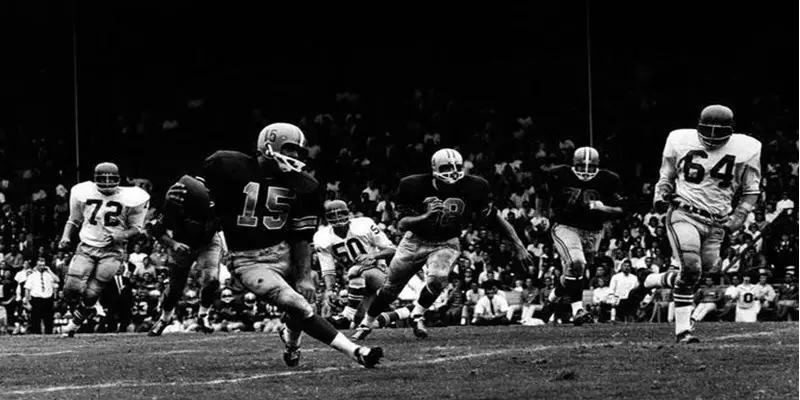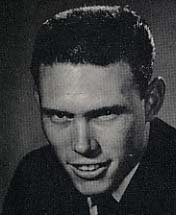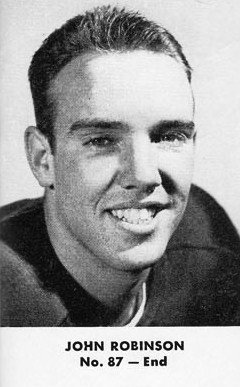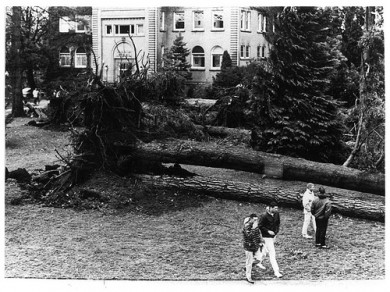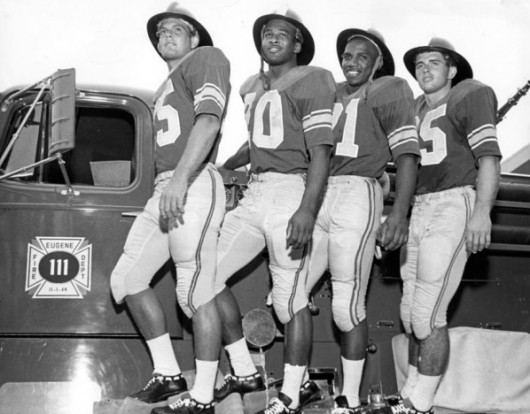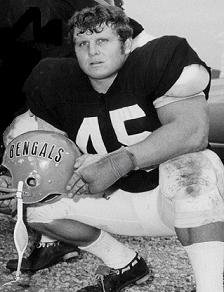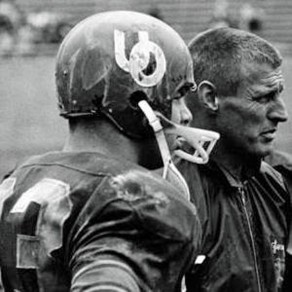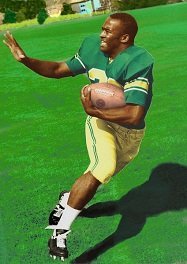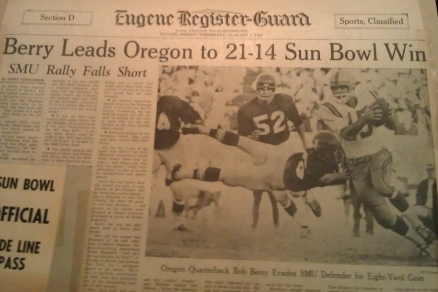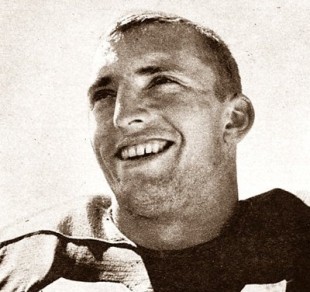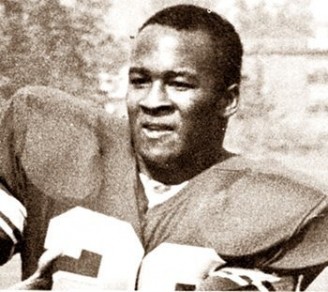At the time they may not have recognized the impact they would have during their time in Eugene, when the young men of the 1960 football recruiting class arrived on campus at the University of Oregon. By the time they were done though the mark in history was undeniable, their achievements at the UO surpassed only by their accomplishments in their professional careers.
The 1963 Oregon Ducks football team featured numerous players that would go on to great athletic careers in the NFL, including two that now grace the NFL Hall of Fame. In addition there were coaches, doctors, lawyers, successful businessmen, and even a US District Court Judge; all utilizing Coach Len Casanova’s lessons to positively impact the world around them.
It was a different era for college football. Freshmen weren’t allowed to play on the varsity team. Coaches couldn’t call plays. Players had to participate on both sides of the ball. Only a max of two substitutions could be made between plays. Teams were split into units (1st unit, 2nd unit, 3rd unit) for mass substitutions after a change of possession. The Oregon Ducks were splitting their home games between Hayward Field and Multnomah Stadium in Portland, and traveling all across the country as an independent school after the Pacific Coast Conference had been dissolved a couple years prior.
Coach Casanova’s Positive Influence
Coach Len Casanova had led Oregon to a bowl game in 1960, a 41-12 loss to Penn State at the Liberty Bowl in Philadelphia, but the 7-3-1 season’s success was not replicated the following year. What Cas lacked in bowl victories he more than made up for in coaching knowledge and ability to lead. His players loved him, his assistant coaches learned from him, and the lessons he provided to those around him have changed countless lives through the actions of those he affected in the time since.
The vast amount of coaches that went on to great success in college and the pros who studied under Cas as a player or coach lists as a who’s who of legends: John Robinson, John McKay, George Siefert, Jerry Frei, Max Coley, Jack Roche, John Madden. Yet for as great of a coach as Len Casanova was on the field, in talking to his many players over the years it is clear that it was his character off the field that led to such a close bond with his people.
“Coach Casanova was a very intelligent person, very successful, and he understood people,” Pat Matson remembers. Matson was a sophomore guard on the 1963 team who would go on to a ten year career in the NFL with the Broncos, Bengals, and Packers. “Cas wasn’t demanding, but he had coaches that were demanding. He had the intuitive knowledge to select good people, and recruit guys that nobody else realized had good potential.”
Paul Burleson, a receiver from Los Angeles, who considered leaving the program after the spring of 61′, remembers how great of a coach Len Casanova was, and what he did to convince him to stay. “Cas knew the game, offensively and defensively, and he knew his players. He knew how to bring out the best in each one of us. He was a psychologist and a hard-boiled taskmaster. Even today, his words ring in my ears, ‘Don’t let up! Keep scrambling, secondary effort wins the game.’ But at the end of spring ball in 1961 I didn’t think I was going to make it and I packed my bags and headed down to the train station.
While I was sitting there Cas showed up out of nowhere and sat beside me. He talked with me for over an hour about the importance of staying with commitment and facing challenges that seem bigger than you can handle. He caused me to realize that a part of my character was being developed in this decision. Cas saved me that night, and it had a profound effect on the entirety of my life.”
“Cas was the guy that got us all there, the players and the coaches, because of who he was and how he was,” said Dick Imwalle, a receiver from San Jose who joined his high school buddy quarterback Bob Berry in heading to Eugene in 1960, together forming a passing tandem that would pay great dividends for the Ducks in the coming years.
“Cas was such a formidable figure, very religious, I’m sure patents sent their kids to Oregon thinking that if anybody could straighten them out it would have been Cas,” Dave Tobey said, a local Eugene product who would go on to a five-year pro career in the NFL and CFL. “Once Cas got the momentum going it snowballed, coaches wanted to go there just to be on his staff, learn a lot, become successful and get a chance to move on to great things.”
The group of freshmen joining the Ducks in 1960 would have to wait a year before proving their merit on the field, as in that era the NCAA didn’t allow freshmen on varsity.
“As freshmen we played four games against other freshmen teams, and swept them all, and we’d often scrimmage against the varsity team, often times we’d beat them good” Rich Schwab recalls, who came to Oregon in 1960 from San Diego following his hero Mickey Bruce (local San Diego high school star and UO runningback/DB 1959-61).
John Robinson was getting his first opportunity to coach when he transitioned from Oregon player to assistant coach to lead the 1960 freshmen team. His career would soar from there, first as an assistant under Casanova, and then as one of the most legendary coaches in USC’s storied history.
“John (Robinson) was a very funny guy, very able and enthusiastic,” remembers Dick Imwalle. “We would scrimmage the varsity team often, and give them all they could handle. It didn’t take long to realize we had some special players with guys like Bob Berry and Mel Renfro. For whatever reason, here was a group of guys all coming to Eugene together that were true winners, for us anything less than winning was unacceptable. We felt like we had a special team, a chance to do something that hadn’t been done for a while.”
Facilities
It seems an odd contrast to see Oregon’s facilities as the envy of the athletic world today, compared to this time when Oregon would split its home games between Hayward Field on the UO campus, and Multnomah Stadium in Portland to accommodate larger crowds. Oregon’s facilities couldn’t compete with the larger schools, and playing at Hayward Field left much to be desired both in capacity and amenities, but it was Cas that held the program together. The stadium was small, but Cas made up for it by compiling a coaching staff that was second to none anywhere in the country, bringing athletes to Eugene for the chance to compete and study under Casanova’s ace staff of football gurus.

Multnomah Stadium
“Our lockers were just a bench with a wood board separating each side,” Dave Tobey laughed. “Guys used to complain because some only had one nail to hang their things, while others had two nails. We’d squeeze 60 bodies into one little room in Mac Court. That was our locker room, our training room, the place for our chalk talks, everything. If you got hurt our medical staff would just rub a little dirt on it, if you were really hurt you’d rub some mud on it. That was about the extent of the treatment of the day.”
“We’d play at Stanford or Washington and their stadiums were gorgeous, I was kind of embarrassed as a player when they’d have to come play at Hayward, this old antiquated stadium,” Ron Jones recollects, a guard from the Salem area who would become a doctor after his playing career.
“When we were first recruited there was talk of a new stadium being built (what came to be Autzen Stadium in 1967), Cas even had a picture he would show us, saying we would be playing there in a couple years. Of course, it took a little longer than expected,” said Rich Schwab. “At halftime of games underneath the stands we were sharing a tiny space with the lawnmowers, guys would sit on buckets or wheelbarrows, that was our halftime. We had a couple leather benches to get taped up, and one single whirlpool for the whole team.”
Finally Getting a Chance To Play
By the 1961 season some of the freshmen were starting to see playing time, their first chance to prove themselves. The team finished a disappointing 4-6, but in particular the emergence of a young running back from Portland named Melvin Renfro created a lot of excitement and hope for the future. Coach Cas would later say, ‘he was the best athlete I ever coached.’
“The first game I ever went to was as a freshman to watch Oregon plat Utah (1962),” Pat Matson recalls. “Mel Renfro touched the ball four times, and ran for a TD every time, it was ungodly. I had never seen a running back like Mel Renfro before.”
By the 1962 season, many of the freshmen from that 1960 team were now regular starters. Playing a very difficult schedule that included trips to #1 Texas and Ohio State, they finished the year an impressive 6-3-1, but the team endured some hardships, ending the season with a sense of unfinished business.
“Our junior years (1962) was probably our best team ever,” remembers Ron Jones. “We were very naive about the horrible racial discrimination down south, so when we traveled to Texas to open the season it was quite a shock to witness that personally. We had black players, and I remember the day before the game Mel Renfro was with us and got thrown out of a soda fountain. They weren’t going to let Melvin stay at the team hotel, but Cas to his credit took it head on. He said ‘if you’re not going to let one of our players stay with us then we’re all going home.‘ It was extra special when we traveled back to Texas later that year to play Rice, and Melvin (Renfro) had his best game, but when we got back the Columbus Day Storm had just occurred, some students were killed on campus.”
The oddities did not end there, as at the same time the Cuban Missile Crisis brought the world to the brink of nuclear war. “During the missile crisis, we didn’t know if we were going to be playing Washington the next week or running up a hill in a war, but we knew one thing: Lt. Bob Berry would be leading us,” Ron Jones quipped.
The 1962 team had lost only to highly-ranked Texas and Ohio State on the road, and had tied Washington, so there was talk of a bowl game in their future if they could defeat Oregon State in the Civil War. The Beavers were led by the eventual Heisman Trophy winner that year, Terry Baker.
The Blue Bonnet Bowl was the prize awaiting Oregon if they could take down the Beavers, and they were well on their way to achieving that, taking a 17-7 lead into halftime. However 2nd half mistakes doomed the Ducks, losing 20-17, leaving the Ducks once again bowl-less.
Steve Barnett and Mel Renfro were named All-Americans, a feat Renfro would repeat in 1963, but individual accolades did not make up for the bitterness of the OSU defeat and missed opportunity of post-season play.
The 1963 Season
The 1963 team would have final say in their legacy, and despite further hardships endure the adversity thrown their way to achieve what had not been done at Oregon since 1917: win a bowl game.
The Ducks featured a lot of offensive firepower in their backfield, a group that was nicknamed ‘The Firehouse Four‘ (quarterback Bob Berry, running back Mel Renfro, fullback Lu Bain, and halfback Larry Hill).
But for all the offensive firepower the Ducks had along with potent receivers such as Paul Burleson, Dick Imwalle, and Rich Schwab; the big question was whether or not Oregon could compete in the trenches.
“Looking back on it, that year was all about change and overcoming obstacles,” said Dave Tobey. “We knew we were going to be good, but what we didn’t have was an offensive line. That was the last year that players were required to play both ways (both on offense and defense), and I think our coaches had a lot of sleepless nights knowing we had all these guys that could run, but who in the heck was going to block for them?
Since guys were going both ways they had to move people around, Ron Jones played guard and I became a lineman by default. I will always admire Dave Wilcox for playing guard, he had never played there before, but when asked he stepped in. We had five untested guys on the line, and Wilcox had never played the position. So we weren’t sure if we could block, but we knew we could move the ball if we could ever figure it out. That was a great accomplishment then for the coaches and guys on the line to get a cohesive unit out of guys who really weren’t linemen.”
The opening game of the 1963 season was a major test, powerhouse Penn State came to Oregon, the game being played in Portland at Multnomah Stadium. The Ducks fought hard that day against the Nittany Lions, but a couple early season errors led to their downfall, losing to PSU 17-7.
“Retrospectively, we didn’t have much of a chance in the Penn State game,” Ron Jones recalls. “The coaching staff really put us through a lot of contact work leading up to that game, and we were beat up from beating each other up. We came into that game feeling like we had just played Washington or something, we were disadvantaged right from the beginning. But after that game we saw the benefit of all that work, we got on quite a roll.”
Indeed, Oregon bounced back in a big way the following week, destroying Stanford in Palo Alto 36-7. The victory proved a sign of things to come, a stout defense and explosive offense showcasing playmakers with speed, led by Berry and Renfro capable of putting up big numbers against anybody. Furthermore, the innovation of the coaching schemes helped Oregon’s defense shut down powerful offenses, while on offense Oregon was ahead of the curve in innovation, finding inventive ways to get players in space.
It would be the following week when Oregon began to make people take notice.
Dismantling the West Virginia Juggernaut
A trip to Morgantown, WV to face the Mountaineers loomed large on Oregon’s schedule, though roadtrips to eastern schools had become familiar with trips to Ohio State and Texas the previous year. Players were warned of the hostile environment, the size of the West Virginia team, and reminded of the brutal discrimination that existed outside the northwest. To get there the team traveled in style, taking a jet for the first time in team history,flying into Pittsburgh, then taking buses to Morgantown.
“When we went to West Virginia, those were the biggest people I had ever seen in my life,” said Pat Matson. “They were all hillbillies, they were really big.”
“The coaches told us to be prepared, that these would be the biggest players we had ever played against and we needed to be as tough as nails,” Imwalle recalls. “They were right too, they were maybe the biggest humans I’d ever seen, but the thing they didn’t tell us is that they had no speed. Put a guy like Mel Renfro in open space and they had never seen anything like that, they had never seen anything like the speed we had. Our coaches were really at the forefront of the speed attack that teams do now, getting fast guys in open space to let them make a play.”
The hostile environment, an area where it is common for fans to rock the buses of incoming teams, and racial tensions amplified during the Civil Rights Movement, remained a very real threat for the fully-integrated Duck team. The need to take extra special care was not lost on Casanova nor the team. So with the Ducks impressive first half showing, racking up an unexpected blowout score of 35-0 against the vaunted West Virginia Mountaineers, Cas did something unusual.
“At halftime Cas would always ask us, ‘What’s the score?'” Ron Jones remembers. “We were supposed to respond ‘zero-zero’ regardless of what the score was. So at WVU he asks it again, but before we could respond he said ‘it is 35 to nothing, and when this game is over it will still be 35 to nothing. That means they will not score, but neither will we.’ Cas knew, we weren’t going to embarrass ourselves by taking a knee, but we were not going to embarrass WVU worse than they already were, wondering if we were going to get out of Morgantown alive. When the buses started rocking we realized, ‘no wonder he said that!'”
“That game was so unusual because the hometown fans were booing their own team,” Paul Burleson recalls. “The fact that WVU was playing poorly that day shouldn’t take away from the fact that we were playing great. At some point around the 3rd quarter I remember saying to H.D. Murphy, ‘They should cheer for us instead of booing at themselves…’”
Dick Imwalle remembers it in a much simpler way, “They were all pretty quiet in the 2nd half.”
True to Cas’ words, when the final seconds ticked off the clock the score remained 35-0. The national media took notice, there was something special brewing out west in sleepy little Eugene, Oregon that was worth following.
The next week Oregon easily defeated Idaho 41-21, setting up a trip to Tucson for a matchup against Arizona that would be nationally televised, a rarity at the time. The Ducks handled business down in the desert, winning 28-12 to cap a 4-game winning streak following the opening season loss to Penn State.
Dave Tobey, playing his first year of varsity football, recalls the 1963 Arizona game vividly. “I had asked Coach (Jerry) Frei (offensive/defensive line coach, later Oregon head coach after Casanova became athletic director) if I could make the travel squad because I had relatives who could make the trip from Texas over to Tucson. Jerry said he couldn’t promise that, but there ended up being a couple injuries so I got to go, and ended up playing.
Afterwards we watched the film and Jerry pulled me aside and said, ‘hey, you had a pretty good game!’ Then Cas spoke to the papers and called me out by name,saying that I didn’t miss one block. That was one of my most memorable moments, Jerry pulling me aside and then Cas saying that publicly, it meant so much to me…it still does.”
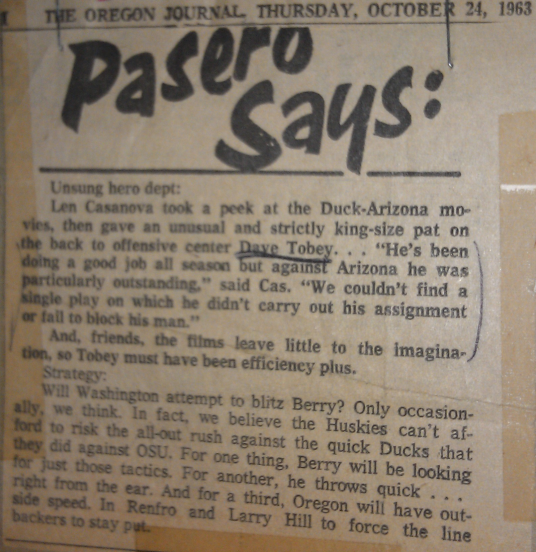
Dave Tobey remains incredibly proud all these years later of what Cas said following his performance in the 1963 Arizona game.
Following the victory in Arizona on national television, Sports Illustrated listed Oregon as the best team in the west.
The Ducks were on a roll, but the team would face its toughest task the next week. Another game at Multnomah Stadium in Portland was on the slate, tasked with taking on the hated Washington Huskies. There was added incentive to get at the Huskies this time, revenge on the mind as the previous year’s game ended in bizarre fashion when some UW students ran onto the field on the final play disrupting what would have been the game-winning touchdown catch for Oregon. Fearing for their lives in the rowdy crowd storming the field in celebration, the refs let the game end that way ignoring the crowd interference on what should have been a last-second Oregon victory, sending the Ducks home bitter wanting a second chance at the Dawgs.
“The UW game in Portland was very close,”reminisced Rich Schwab. “Renfro got hurt on a big hit, he missed the next week’s game too (against San Jose State) because of it. Every game we played against Washington was tough, those were always physical, tough games, smashmouth football.”
Oregon again would fall just short vs. Washington, while losing tackle Milt Kanahe, Mel Renfro and Bob Berry to injuries but still with a chance to drive the field at the end if not for a fluke interception, losing 26-19. The after-effects of the Washington loss would be felt the following week, playing an inferior San Jose State team that featured Bob Berry’s younger brother Kenny Berry at quarterback, but on paper were no match for Oregon.
“From our perspective, the one game we’d all like to have back was San Jose State,” said Dick Imwalle. “Bob (Berry) was hurt, Melvin (Renfro) was hurt. We ended up playing most of the game with Lu Bain at quarterback, and he’d roll to the left or right and run with the ball because we couldn’t do anything else. 9 times out of 10 we win that game 9 1/2 times, but we lost it, 13-7. We were being considered perhaps for the Orange Bowl if we had won that game and won out, but at that point we were so banged up.”
“It was tough, but we were a resilient team, I’m not sure people recognized how good of players we actually had,” said Dave Tobey. “Every game we seemed to come up and play well, and when guys were hurt others would step in.”
Still suffering from injuries, Oregon quarterback Bob Berry gritted through the pain returning to the field to play at Washington State the following week, determined to end the two-game losing streak marred due to injuries to himself and Renfro. The Ducks fought to a 21-7 victory over WSU, but by the end Berry could barely walk.
At 5-3, Oregon still had a shot at a bowl game, but injuries were taking their toll. Berry and Renfro returned to action, but other injuries were forcing young players into the lineup. Their task didn’t get any easier, as the Indiana Hoosiers were next on the slate, a top-10 team, considered by many the second best squad in the Big-10. The game would once again be held at Multnomah Stadium in Portland to accommodate the larger crowds. What they would witness remains to this day one of the most memorable games in Oregon history.
The game was a brutal back-and-forth affair, with Oregon’s hopes for a great season possibly dashed when Indiana hit a field goal with less than two minutes remaining to take the lead 22-21.
Fireworks were in store for the Oregon fans eagerly waiting to see if the Ducks could eek out a last minute victory. Driving the field, Berry first connected on a long pass to Mel Renfro. Then with only seconds remaining on the clock, Berry threw a perfect pass to H.D. Murphy in the back of the endzone to win, 28-22.
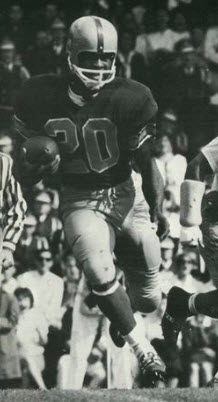
Mel Renfro
“The Indiana game was one of the best football games we ever played,” remembers Ron Jones. “They were ranked in the top 10, and we were down six linemen due to injuries. I had to play 1st team left guard, 2nd team right guard, and 3rd team left tackle. I ended up playing all but three minutes of that entire game, that was one of the real highlights of my life. We always lost to Big-10 teams, that was the first time Oregon had ever beaten a Big-10 team I think. We always had to play them on the road, because none of them were ever going to come to Hayward.”
Re-energized by the last-second comeback, the Ducks were feeling good until once again events from off the field would test Oregon’s merit. First the nation was traumatized with the shocking assassination of President John F. Kennedy, much like the year prior with the team having to prepare during the uncertainty of the Cuban Missile Crisis and locally dealing with the aftermath of the Columbus Day Storm. Then Mel Renfro suffered a hand injury that would keep him out of the Civil War game and any post-season play.
But the Ducks would prove resilient once more, making quick work of the Beavers the following week to close out the 1963 regular season, defeating OSU 31-14 despite not having Mel Renfro available, finishing 8-3 on the year.
The 8-wins tied for the most in Coach Casanova’s coaching career, and the team was invited to play in the Sun Bowl.
The Sun Bowl
On paper Oregon appeared to be the better team in the 1963 Sun Bowl at 8-3, facing a SMU team that had finished 4-7. However, Southern Methodist had started the season by defeating Navy, the consensus #1 and preseason selection to win the national championship–led by quarterback Roger Staubach. El Paso, TX, site of the Sun Bowl, was practically SMU’s backyard. Technically it was a neutral site game, but for Oregon they knew full well this was going to be a tough playing against a scrappy team in their own territory and a hostile environment. Unlike today, there were few post-season bowl games, so the opportunity to play in any game was a big deal.
“It was a great experience,” said Rich Schwab, “we had never been to a bowl so we didn’t know quite how to act. It was supposedly a neutral field, but it was like us traveling to Portland. They had a lot going for them (SMU), and Renfro couldn’t play because of his hand. Dennis Keller was our back, but he was no Renfro so we lost our best talent.”
“We were nervous about playing them,” said Dave Tobey. “We knew they were capable of playing good ball, we didn’t want to be embarrassed by them. Even though SMU was local, that was the first year that the Sun Bowl had big time teams, before that they’d had small schools. Berry was our big star, Melvin (Renfro) was there but couldn’t play. All the festivities were great, but Cas kept a close eye to make sure we didn’t get out of line, and nobody wanted to cross Cas. We jumped out to a 14-0 lead and hung on late to win 21-14. We were happy to get the win.”
Paul Burleson remembers fondly his performance in the 1963 Sun Bowl. “The greatest moment of that game for me came with less than a minute to play in the half. Berry had called a play in the huddle that flanked me to the left side. I only glanced at the defense as I came up to the line and was looking down to make sure I was lined up onside and was leaning towards the center to hear if there was an audible. Sure enough Bob changed the play to ‘Blue 82’ which was my call for a center post. I look up, and low and behold to my surprise there was only one man guarding me as their safety had shifted over to the right, leaving the post pattern wide open. ‘Good call Bob!’ I thought. I ran a Z post, caught the ball thumbs out over my head in the endzone, which ended up being the game-winning touchdown.”
Burleson continued, “The fact that this was Casanova’s only bowl win made this touchdown catch my way of saying ‘Thanks Cas for talking me out of leaving back at the train depot in the spring of ’61.'”
Oregon had won their first bowl game since the 1917 East-West Tournament Game (later known as the Rose Bowl). It would be Oregon’s last bowl visit of any kind for 26 years, not playing in another until the 1989 Independence Bowl.
The Impact of the 1963 Season
Coach Len Casanova would never again have a team quite like the 1963 Ducks, Cas’ last great team. Dave Wilcox and Mel Renfro left for careers in the NFL that would eventually land both in the NFL Hall of Fame. Pat Matson joined the Broncos to start a 10-year career in the NFL. Others got opportunities to play professionally in the NFL or CFL. But the accomplishments of those who hung up their jerseys for good were just as impressive.
Ron Jones became a successful doctor. Ancer Haggerty pursued law school, eventually becoming a US District Court Judge. Others went on to successful careers. For many of the players, they would take the lessons learned under Cas and the tremendous coaching staff and spread that knowledge onto others, becoming coaches at various levels.
But things changed after the peak of the 1963 season. Oregon was still able to attract players that would find their way to the professional ranks, but the caliber of team as a whole couldn’t compare to the resiliency of the 63′ squad. In the wake of this high-water mark Oregon would begin to flounder, then lay dormant for decades mired in losing seasons and embarrassing blowout losses, until Oregon’s re-emergence in the late 80s. Like the crest of a wave before it comes crashing down on the shore, the 1963 season stands out as the last great hurrah for the University of Oregon before the modern era of football began.
“The worst loss we took as freshmen all the way to our senior year was 10 points, we never got blown out,” said Ron Jones. “Then after we left the Ducks got blown out all the time. What really hurt us older players was they’d get blown out by big teams, 66-0 or whatever. Our pride was too big for that, it didn’t matter who we were playing, we were not going to let that happen to us.”
The following year Oregon joined a new conference, the Athletic Association of Western Universities (later known as the Pac-8, then the Pac-10, now Pac-12). This marked the end largely of Oregon’s consistent cross-country escapades. In 1967 Len Casanova retired from football to become the University of Oregon’s athletic director, elevating Jerry Frei to head coach. Cas remained active with the university in various capacities until shortly before his death, and for his efforts to grow the program the Casanova Center is named in his honor. Len Casanova was elected into the College Football Hall of Fame in 1977. But after Frei was let go following the 1971 season, Oregon entered a dark period, becoming a perennial hard-luck loser until well into the 1980s.
The memories over the years start to fade, but what has never dissipated is the unbreakable bond of brotherhood felt between those who played on the 1963 Oregon Ducks football team. These days they’re moving a bit slower, feeling the long-term effects that come from playing football. Every year guys from the 63′ team gather in Arizona for a golf tournament, a chance to share memories, stretch a few stories (to “fill in the gaps” as it was explained to me), and relive the great times.
“All the guys really bonded together, and we had some good players. Wilcox and Berry and Renfro and Schwab and Tobey; a lot of people that nobody expected to be really good but played hard,” Pat Matson fondly recalls of his teammates.
“I think 1963 was a turning point in Oregon football,” Dick Imwalle proudly stated. “It was a high-caliber of athlete on the 1963 team. It demonstrated that Oregon could in fact attract quality players. Most could have gone elsewhere, but for whatever reason we all decided to go to Oregon, and we all became over-achievers.”
“We were all just good people, good players,” Dave Tobey recalls. “Cas instilled in us good ideals, we came out of not only college athletics but in life as really good citizens. Seeing the success that everyone on this team has had is wonderful. We were just a high-quality group of people who also happened to play really good football. We still cherish that team and those guys, they are about as close to us as many of our family members, because of what we lived through those years.
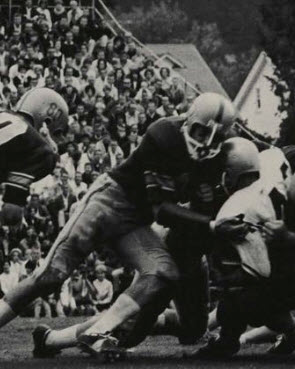
Ducks playing defense in 1963.
People should look back and be proud that here was a group of guys that yes they won football games, but they also did a lot for the community, for the youth, and were just great people. We all moved on to coach youth football and share the values that Cas taught us. The quality of the individuals that comprised that team is what I want people to remember.”
While some of the guys that fought so valiantly back then endure the permanent scars and aches from their glory days on the field (Pat Matson has had 31 surgeries due to his playing days), the pride of their accomplishments and bond with their teammates overcomes any lasting effects of their sacrifices. For all who participated, the 1963 season remains a lasting memory, a great time that forever changed their lives.
Ron Jones summed it all up this way…
“Whenever my wife sees me limping around today in pain she asks me the same question, ‘was it worth it?‘ She always expect me to say no, but I respond, ‘Yes $#&*@% it was worth it, because I got to play with those guys.”
——-
Where Are They Now:
Paul Burleson, wide receiver (1960-1963)
Paul Burleson spent one year in the CFL with the BC Lions, then returned to Oregon to coach at Drain High School before acquiring his master in Psychology from the UO in 1974. In the 1980s Paul signed on with L.A.U.S.D. as an Attendance Counsel, retiring in 2006. Paul and his wife Gail reside in Menifee, CA, where they pass the time as singing storytellers at various special events.
Dick Imwalle, tight end (1960-1963)
Dick Imwalle in 1978 became Vice President of the University of Arizona, and President of the UA Foundation, where he stayed until retiring in 2005. He helped establish the Bank of Arizona, and was chairman of the board for 15+ years. His son played football for the University of Arizona, but he stuck to his Oregon roots cheering for the Ducks despite his Wildcat connections.
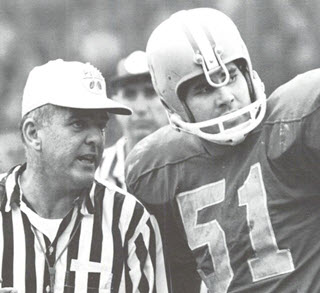
Dave Tobey talking with Ref in 1963.
Pat Matson, guard/tackle (1962-1965)
Pat Matson played 10 years in the NFL with the Denver Broncos, Cincinnati Bengals, and Green Bay Packers. He was the player rep during the first NFL strike. After his playing days he established some of the first public fitness centers, and developed a juice product that was sold around the world. Later he sold cars under Roger Penske for years.
Dave Tobey, center/linebacker (1962-1965)
Dave Tobey, a Eugene native who grew up a Duck fan, got to live his dream of playing for Oregon. He then went on to play five years of professional football with the Minnesota Vikings, Denver Broncos, and BC Lions of the CFL. Tobey returned to Eugene and began managing athletes in the 1970s, before entering pharmaceutical and medical sales for 38 years. Recently retired, he lives in Palm Desert, CA.
Ron Jones, guard (1960-1963)
Ron Jones wanted to be a high school football coach, but Jerry Frei convinced him otherwise. Carrying nearly a 4.0 at the UO, Jones completed pre-med while playing football, and after graduating from medical school became the director of labs at Kaiser Permanente in Portland, were he stayed until 1989. He became a professor at the University of Iowa, and a close friend of Iowa football Head Coach Hayden Fry (who had coached SMU in the 1963 Sun Bowl), relishing in Oregon’s victory over Iowa in 1989. He resigned from the university in 2000, and to this day continues to operate a successful laboratory in Iowa City, one of the four leading research labs for antibiotics in the world.
Kurt Liedtke
Klamath Falls, Oregon
Thank you to the Casanova Center and Jeff Eberhart for assisting in coordinating this interview and other content for FishDuck.com.
Top Photo of Bob Berry from the UO Libraries Special Collections and Archives, as are the other pictures.
Related Articles:
These are articles where the writer left and for some reason did not want his/her name on it any longer or went sideways of our rules–so we assigned it to “staff.” We are grateful to all the writers who contributed to the site through these articles.

